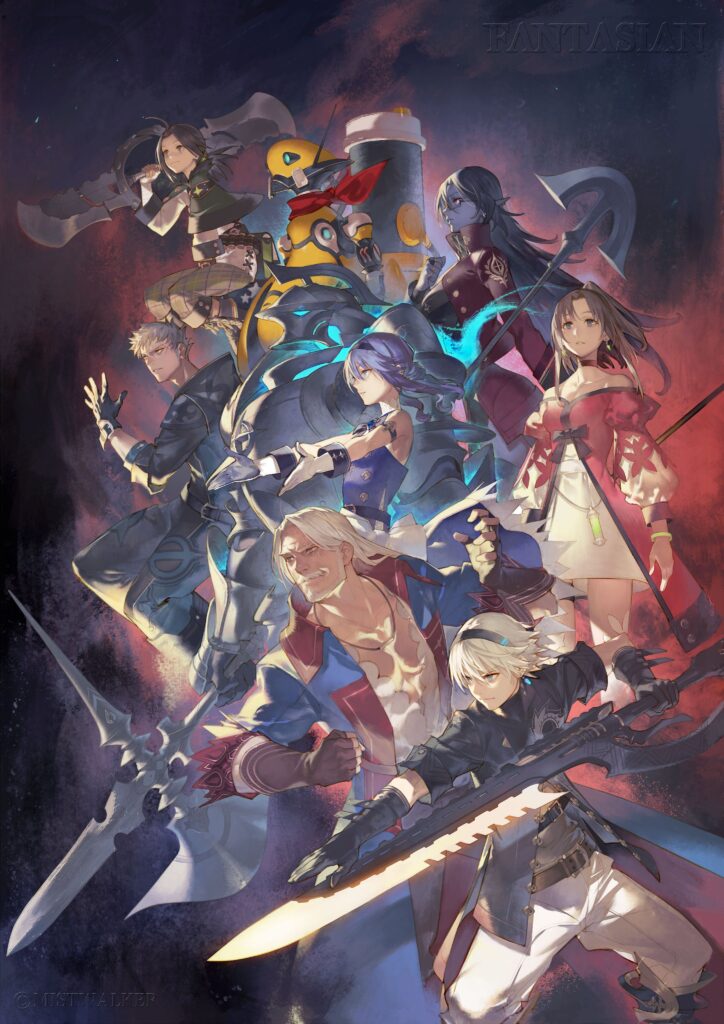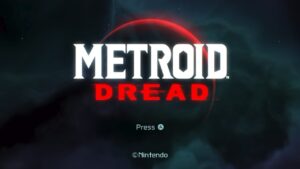“FANTASIAN” by Mistwalker Studios Review

Photo courtesy of Mistwalker Studios via Twitter.
Intro
Mistwalker Studios have made their name making Final Fantasy-esque games for non-Sony systems. Founded by Hironobu Sakaguchi of Squaresoft/Square Enix fame, they’ve made their mark creating Japanese Role-Playing Games (JRPGs) that both capture the essence of the genre while building on it mechanically and narratively. FANTASIAN is no exception, bringing their expertise home to yet another new platform — Apple’s iOS, Mac and Apple TV. It’s a typical JRPG, which roughly means that it has a set cast of characters that fight in turn-based combat—the player tells the character what to do and the character carries out those actions. The genre is known for narrative depth, often repetitive battles, and top-notch music.
Before I get into the praise I have for the game, I need to talk about the opening hour. The game starts with the main character, Leo, waking up on the floor of a factory with two robots. He has head-injury caused amnesia, the tired trope where he has forgotten whatever the writers find convenient for him to have forgotten. While in this prologue, Leo has limited capabilities, a robot party member with access to skills that won’t again be relevant for another ten hours, and largely portrays the game as more barebones and by-the-numbers than it is. Luckily, this section only lasts maybe an hour, but it does, unfortunately, mean that the game has a time commitment before it “gets good.” With that out of the way, let’s get to it.
Presentation
FANTASIAN’s presentation is likely to be its most lasting impact. While the big name attached is of course Final Fantasy composer Nobuo Uematsu, doing potentially his last full score, the art style is the true star. Mistwalker went out on a limb, combining the principles of a world made from real materials seen in games like Yoshi’s Wooly World or Tearaway with the pre-rendered background style of PlayStation games to create a beautiful aesthetic accurately termed in the marketing as a “diorama RPG”. Considering they worked with over half a dozen companies to make the dioramas that would be the settings of the game, this is an apt name indeed. The result is often honestly breathtaking, and the team’s decision to not give the player camera control allows them to position it instead where they can create the effect that they want, rather than what the player finds convenient; this is used both to create gorgeous vistas and, perhaps more directly, to hide chests and other goodies in a natural way, encouraging exploring in order to see the area from other angles. That said, the game does occasionally zoom in close on a character against a dated backdrop that ruins the effect—but that is uncommon.
The sound effects are serviceable—I’m fond of the dialogue bleeps (the game is unvoiced) and footsteps, but less so the sound of dropping down a pin on the ground for the party to move towards. The score however is quite good. While I don’t think it reaches the heights of some of Uematsu’s work, the battle theme is a jam, the character themes are packed with the appropriate emotion, and the more atmospheric area soundtracks are varied and fit the moods well. My favorite has to be the Machine City theme, though there isn’t an official way to stream the track—it’s a downright industrial melange of everything from synths to what sounds like an instrument made out of the sounds of a dial-up internet connection. It feels new and bold (though it isn’t, really, in terms of music). Overall, it’s a great effort on Uematsu’s part, and I hope it’s treated as fondly as his Final Fantasy work.
Gameplay

The meat and potatoes (so to speak) of any JRPG is its combat—the lion’s share of your time interacting with the game will be doing combat, and FANTASIAN does a great job with it. While your characters don’t move from their positions on the battlefield, most of their abilities target areas or arcs, giving you both more options in combat and a feeling of being in control of the battlefield. Characters fight with a wild variety of weapons that function differently in combat—ranging from the typical swords and fists to lanterns and massive boomerangs. Boss battles are often epic, and incorporate elements of puzzles more often than not, helping to distinguish them from each other. However, the real pièce de résistance is the use of the Dimengeon.
Early in the game, you acquire use of a piece of tech that allows you to store the monsters you would battle, which randomly attack you on the map, to fight as a larger group later. Not only does this let you avoid interruptions while trying to navigate a map or solve an environmental puzzle, but it also lets you have these longer, drawn-out fights against a crowd, mixing up the types of combat you get to deal with. It’s an effective and unobtrusive way of almost getting the best of both worlds.
That kind of modern user-friendliness is a theme in the game. The other major gadget that Leo utilizes is a warp device his father built. In addition to this justifying the mid-game addition of a fast travel (or warp) device, it sets up a narrative conceit for why you have a one-button warp to get to quest destinations. There are also mid-screen points of interest you can choose to walk towards—and the pathfinding is strong enough that if you’re gathering monsters in the Dimengeon, it’s a great option for sitting back and enjoying the show.
These factors combine to make a very easily playable game. I found myself actually sitting down and spending a couple of hours on it on my phone, despite my general dislike of touch-screen controls. Other than a few times where I didn’t have much room to work with for aiming attacks and the fact that certain other apps would cause it to shut down when in the background (a rough prospect when the game uses some checkpoints but primarily save points to record progress), the game played well.
Narrative (Spoilers Ahead)
First things first: this is only half of the story of FANTASIAN. At the end of the roughly 15-hour story, you reach an “End of Part One” and an assurance that the other half of the story, a less linear experience, will be coming possibly later this year.
Of course, the real question with any sort of narrative is what kind of story are they telling. In FANTASIAN you are placed in a world where a powerful entity is polluting the human realm with Mechteria, or mechanical bacteria, that is taking over landscapes and killing people. It’s very evocative of a mix of space-age tech and the toxic jungle from Nausicaä of the Valley of the Wind, which works well. Most of the plotting is quite serious, though moments of levity, such as a recurring trio of absurd villains known as the Cinderella Tri-Stars are present as well, to keep things from becoming too morose.
You primarily play as Leo, who is an amnesiac inventor of sorts. You’re joined quickly by Kina, who was found in the woods and raised by a fortune teller. Cheryl, or Princess Cheryl, who is the heir to a queendom, Zinikr, a ship captain whose cruise ship you ride upon, and Ez, an orphan gadgeteer, round out the party.
Largely, the characters are enjoyable. Leo does tend to be overly competent, but he is the butt of pretty reasonable jokes. Kina is a kind of spunky girl-next-door expy of Aerith, while Cheryl is an ice queen with good reason to hold a grudge against Leo (and indeed her elemental magic is ice). None of these are highly original, but they’re all done fairly well.
It gets a little murkier with some of the other characters. Ez is mostly a brat who stirs up trouble, and Zinikr can be a bit overly lewd in a way that is pretty common for the genre but isn’t really appreciated. He’s nowhere near as bad as the minor character of Cheryl’s father who you find rummaging through her underwear drawer—and I wish that wasn’t the case, but I also don’t think it’s appropriate to ignore that occasionally the game does go there. Most of the time it’s written much more respectfully; characters even have interesting designs that aren’t designed around showing skin. I’m particularly fond of Cheryl’s dress, which in-universe is also considered quite fashionable.
Most of the tale takes place either trying to recover Leo’s memories or trying to figure out Kina’s past, though both of these take a back seat to reacting to the troubles they find themselves in. One of those key events took place about halfway through, where Kina and Cheryl are abducted, and results in playing as them for about an hour before playing as the other characters mostly throughout the rest of the game. Up until then, these are characters that have a reasonably large amount of agency, and then they get put into a crystal. It’s less than ideal and I think it’s something that, in the context of the full game, won’t be as bad.
Screenshot by Morgan L’Fey on iPhone 12
The other part of the narrative that I think suffers from the two-part nature of the release is that the game is building up to a large combat against a big bad, and there are plot things that are revealed, an escalation of consequences, and all of that good stuff that would lead to a cliffhanger.
Then there’s another hour and a half of gameplay, during which they introduce new characters, new concepts, and even a new gameplay system, then it just stops. It’s just disorienting because the game feels like a two-part experience. It should have ended as the cutscene ended after that big boss battle and instead you go as far as the next boss before it ends, which is just odd. It sort of lessens the impact of what they built up to.
Conclusion
If you have Apple Arcade and enjoy JRPGs then I highly recommend it. For others, it might be a harder sell, but its short runtime for the genre (I got to the credits in roughly fifteen hours) and unique presentation might be enough to keep them invested.
Scores:
Presentation: 9/10
Gameplay: 8/10
Narrative: 5/10
Overall: 7/10



